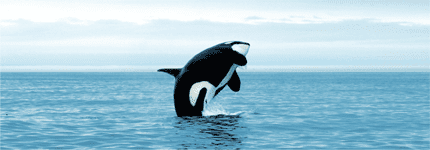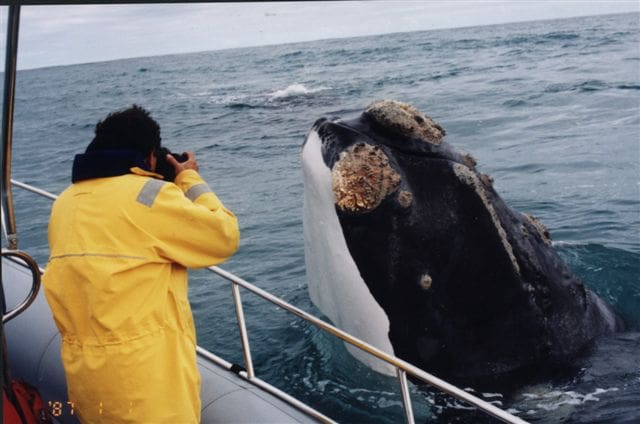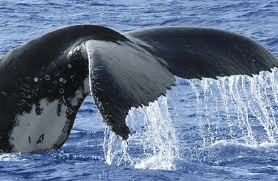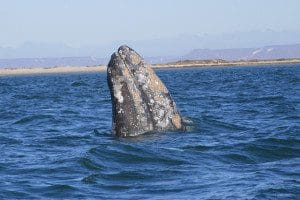 A huge black and white orca fully breaches out of the water and his eight ton body lands with a terrific splash. His pod of 30 family members frolics playfully as they jump and slap their tails on the water’s surface. A baby whale hangs vertically in the water with his head held high out of the water “spy hopping” to see what is going on. A massive 50-foot long, 35-ton gray whale swims along side of the boat to “people watch” to the delight of the whale watchers.
A huge black and white orca fully breaches out of the water and his eight ton body lands with a terrific splash. His pod of 30 family members frolics playfully as they jump and slap their tails on the water’s surface. A baby whale hangs vertically in the water with his head held high out of the water “spy hopping” to see what is going on. A massive 50-foot long, 35-ton gray whale swims along side of the boat to “people watch” to the delight of the whale watchers.
 Whale watching is a popular tourist activity all along the Pacific Coast. You can see these marvelous marine mammals, sometimes up very close, on excursions by boat, kayak or plane. Orcas, Gray whales, giant Blue whales, Sperm whales and Humpbacks all live along the Pacific Coast. The prime viewing season varies, depending on the species of whale and their migratory routes. For example, Gray whales swim from their summer feeding grounds in Alaska south to their breeding grounds in Baja California, Mexico from December to February, then return northbound with their calves February through April.
Whale watching is a popular tourist activity all along the Pacific Coast. You can see these marvelous marine mammals, sometimes up very close, on excursions by boat, kayak or plane. Orcas, Gray whales, giant Blue whales, Sperm whales and Humpbacks all live along the Pacific Coast. The prime viewing season varies, depending on the species of whale and their migratory routes. For example, Gray whales swim from their summer feeding grounds in Alaska south to their breeding grounds in Baja California, Mexico from December to February, then return northbound with their calves February through April.
In the Pacific Northwest, the season is mid-April through early October. San Juan Island is one of the best places to see the black and white Orcas, or killer whales, because they stay there about six months a year feeding on their favorite food, the Chinook salmon. Orcas and Grays are also found all along the Oregon and Washington coasts.
 Further south, along the California coast, the most common whale of the region is the Blue Whale which travels in pairs during their migration in July through October. Blue whales are the largest animals on earth at 70-90 feet long, so sightings make a big impression! Over 20,000 Gray whales travel the California coast twice a year in their long round trip and the Santa Barbara Channel is a prime viewing area December through April.
Further south, along the California coast, the most common whale of the region is the Blue Whale which travels in pairs during their migration in July through October. Blue whales are the largest animals on earth at 70-90 feet long, so sightings make a big impression! Over 20,000 Gray whales travel the California coast twice a year in their long round trip and the Santa Barbara Channel is a prime viewing area December through April.
During winter, thousands of Humpback whales migrate to the warm waters off of the Hawaiian Islands to mate, give birth and care for their young. The viewing season runs from early November through mid-May, with a peak in February and March. Maui is considered the prime whale watching island in the Hawaiian chain and although whales can actually be seen from shore, the best views are from whale watching vessels.

Baja Mexico enjoys an even longer whale viewing season – practically year-round – as the California Grays, Humpback, Blue, Fin and Orcas all use this part of the warm Pacific for breeding and as a nursery for their young calves.
If your travels take you anywhere on the Pacific coast during one of these migratory periods, don’t miss the action! Better yet, let Covington Travel help you plan a trip specifically to see these behemoths of the ocean. Their size, grace and familial tendencies are amazing to behold.






[…] the Old Town Trolley. (Travel Maestro tip: If you visit from December to March, be sure to take a whale watching tour to see hundreds of gray whales during their annual migration […]